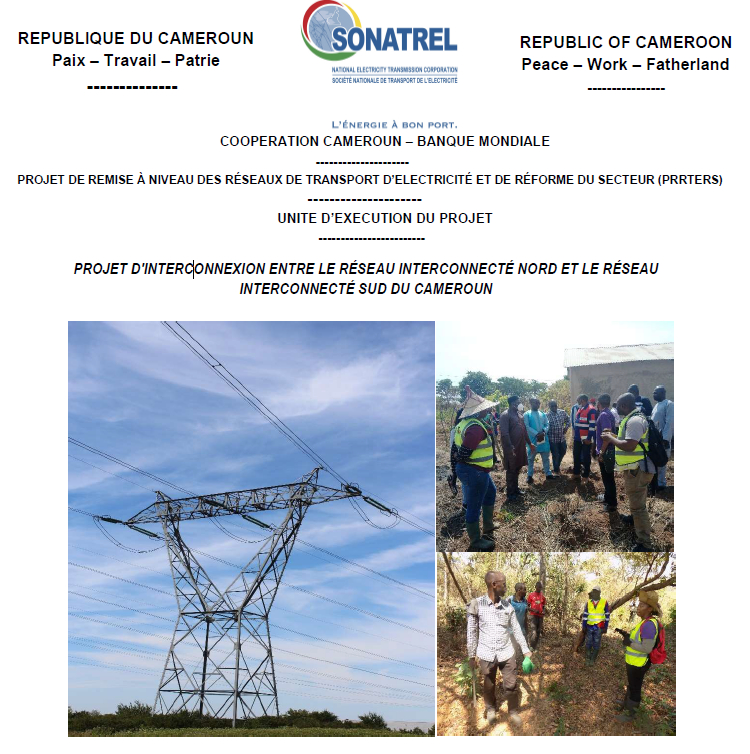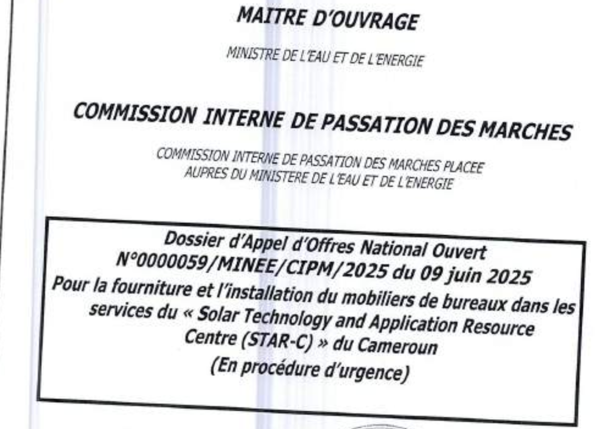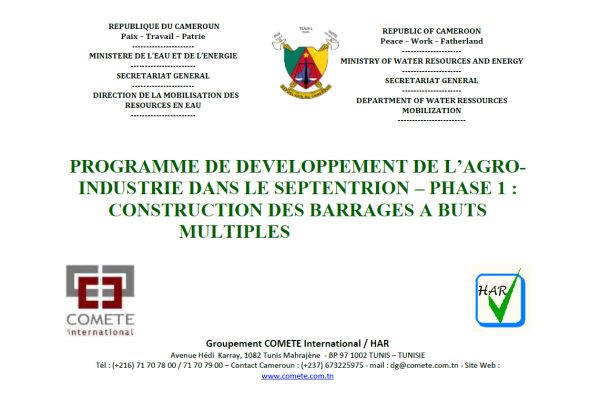RELOCATION ACTION PLAN (RAP) – Project PIRECT

NON-TECHNICAL SUMMARY
DOWNLOAD VOLUME 1: MAIN RESETTLEMENT ACTION PLAN (RAP) REPORT – Project PIRECT_Sept 2023
BACKGROUND AND RATIONALE FOR THE PROJECT
In its desire to guarantee the security of energy supply of the country, the Cameroonian government developed in 2014, a Development Plan for the Electricity Sector by 2035 (PDSE 2035). This plan aims to solve problems such as overloading lines and service transformers; an unoptimized configuration of the network, the obsolescence of the equipment, the inability to absorb the energy produced by the production plants envisaged in the short and medium term.
The World Bank, through its International Bank for Reconstruction and Development (IBRD) window, is supporting the Government of Cameroon in the implementation of this program, through the financing of a set of works whose purpose aims, among other things, the evacuation of the Nachtigal and Memve’ele dams, the strengthening of the South and North Interconnected Networks.
As part of the implementation of PIRECT, the World Bank through SONATREL commissioned a Resettlement Action Plan (RAP). The completion of this project could result in the loss of property and
income for a number of people located along the interconnection corridor. This study, which focuses on the Resettlement Action Plan (RAP) of the 530 km RIN-RIS Interconnection Project, is prepared in
accordance with Cameroonian laws and the requirements for the Resettlement Action Plan contained in World Bank Operational Policy 4.12.
GENERAL METHODOLOGY OF THE STUDY
For the preparation of the action plan for the reinstatement of the interconnection project between the northern interconnected network (RIN) and the southern interconnected network (RIS), the Consultant carried out an inventory of the assets and persons affected by the project jointly with the CCEs of the departments concerned (Lékié, Mbam and Kim, Djérem and Vina), and individual socio-economic surveys of each person affected by the project. Several scoping meetings were organized with PIRECT for the framing of field activities, as well as with the CCEs of the departments concerned. This is the meeting of 22 September 2022 with the PIRECT PMU, which was intended to allow the Contracting Authority to give instructions and guidance to the Consultant on the work to be done and the results to be achieved. It also allowed the Consultant to present the working methodology to be deployed for the conduct of the RAP, then to receive SONATREL’s comments on this methodology. There is also the meeting of October 6, 2022, which brought together SONATREL, PRRTERS, PIRECT PMU and the Consultant. The objective of this meeting was to jointly prepare the technical workshops for the impregnation of CEC members on the process of identification and valuation of assets to be adopted and the development of compensation decrees within the framework of the RIS-RIN interconnection project.
ECONOMIC CHARACTERISTICS OF THE PROJECT INTERVENTION AREA
The field trip in the four departments concerned made it possible to identify the socio-economic characteristics of the populations of the riverside villages as well as those of the people affected. The data collection shows that in the project area, the main economic activities are agriculture, livestock, and handicrafts, processing of agricultural products and small trade and beekeeping.
LEGAL AND INSTITUTIONAL CONTEXT GOVERNING THE PROCESS OF EXPROPRIATION FOR PUBLIC
UTILITY
The project will be inspired by Cameroonian legislation in the field of property rights, land classification, expropriation and the method of identification of beneficiaries and compensation. Similarly, it will also use international directives. The land ownership regime in Cameroon is governed by Ordinance No. 74-1 and No. 74-2 of 6 July 1974 establishing the land and state regime which defines private and public property.
The World Bank’s operational policy 4.12 on involuntary resettlement is also applied in the context of this development project, whose activities affect populations, including the destruction of their production systems or the loss of their sources of income, restrictions on access to or use of natural resources and which require displacement of these populations.
INVENTORY RESULTS AND VALUATION OF ASSETS
The inventory of properties was conducted at the same time with the CEC in all the departments, districts and villages crossed by the project. In total, for the works to be built, 1185 people affected by the corridors of the lines, transformer stations and access roads were identified as follows: 9 PAPs in Lékié, 700 PAPs in Mbam and Kim, 263 PAP in Djérem and 197 in Vina.
The main types of PAPs are as follow: physically displaced persons, economically displaced persons and vulnerable groups.
For the impacted properties, the consultant identified the titled land for a total affected area of 353,227.8m2, i.e. 35.32ha and a developed area of 342,404.766m2, belonging to individuals and 5.8 ha belonging to the national domain. . The cost of compensation for titled land amounts to 1,217,295,815 CFA francs.
For untitled land, the consultant identified an affected area of 7196805.086 m2 and a developed area of 6371902.42 m2. The total cost of the developed area amounts to 559816735.6 F CFA. In terms of buildings, 290 buildings belonging to 136 PAPs have been identified in the project right-of-way corresponding to a total cost of 393,791,579 CFA francs.
In terms of constructions, 290 buildings belonging to 136 PAPs were identified in the project footprint corresponding to a total cost of 393,791,579 CFA francs.
For collective goods and tombs, 20 constructions (including the 4 buildings of the Djalbarké military camp to be moved) have been identified, while 38 fitted and unfitted tombs for a total cost of 10,870,000 CFA francs have been identified in the area influence of the project. It should be noted that compensation for the relocation of the 04 military buildings has not been integrated into the RAP, because World Bank policies do not allow the financing of military infrastructure. That’s why the relocation costs of these infrastructures will be covered by the Government of Cameroon.
The total cost of compensation for the crops identified in the project area amounts to 4,027,485,020 CFA francs. In addition to these properties, the consultant recorded cemeteries and sacred sites on the corridors of the HTB line. A total of four cemeteries and four sacred sites have been identified in the project’s footprint. The evaluation of these sacred sites is estimated at 4, 045,100 F CFA.
RESETTLEMENT MEASURES
Public consultations and socio-economic surveys conducted among PAPs during field trips made it possible to select specific and targeted measures. These measures include actions on: (i) assistance to PAPs during the compensation process; (ii) restoration of livelihoods of PAPs who will be displaced as a result of the Project; and (iii) accompaniment and assistance to vulnerable PAPs.
Field surveys carried in the 111 villages along the HTB line corridor identified 1,185 people affected by the project, among witch we have 136 physical displaced.. Assistance measures for eligible persons began during census activities. These measures concern the assistance of PAPs during the compensation process, the restoration of means of subsistence, measures to assist in the use of
compensation costs and support for physically displaced persons.
MEASURES TO STRENGTHEN SOCIAL INITIATIVES
Field surveys in the various villages along the HVB line corridor identified 1,130 people affected by the project and 111 villages. In view of the significant social consequences of this project, the electrification of localities located within a 10 km radius on either side of the 530 km long HV line corridor has been identified as a relevant enhancement measure. The activity is under construction within the scope of the ongoing project’ structure review.
The total estimated cost of electrifying villages located no more than 10 km either side of the RIS RIN HVB interconnection line corridor is XAF 28 505 600 000, thus € 43 520 000.
ASSISTANCE TO VULNERABLE PERSONS
Vulnerable groups as defined in policy 4.12 are those who are in precarious social or economic situations, and unable to take advantage to the same degree as others, of the opportunities or natural resources of their environment, or who are at risk of becoming more vulnerable as a result of displacement and resettlement.
The socio-economic surveys conducted in the field as part of this RAP have identified the following vulnerable groups: the elderly, single women, widowed women, chronically ill people and people with disabilities who have a small number of vulnerable people. In total, out of 995 people surveyed, were identified as vulnerable people in localities crossed by power transmission lines, transformer substations and access roads and transformer substations, representing 120% of the total number of people affected. Among the vulnerable are 83 men and 38 women. These people may be made even more vulnerable during an operation to move their place of residence because they have a reduced capacity to adapt because of their disability or their limited financial resources. Vulnerable people will benefit from a package of compensation and livelihood restoration measures. The assistance’s measures will consist of: information of vulnerable persons, support for resettle land research, relocation’s support, training/coaching for the good management of the compensation, food support, financial support, medical support, including support to the delivery of Identification documents to PAPs without ID cards.
STAKEHOLDER CONSULTATION
Stakeholder consultations under this RAP began with individual consultations on 05/06/2022 in the Adamawa region and on 08/06/2022 in the Centre region as part of the Environmental and Social Impact Assessment (ESIA). In addition, as part of the preparation of the PAR, three (03) impregnation workshops of the members of the Commissions of Observation and Evaluation (CCE) on the process of identification and evaluation of property and development of compensation decrees were organized by PIRECT in the districts of Ntui, Tibati and N’Gaoundéré3rd. During the field activities, the stakeholder consultation consisted in informing the public through the kick-off meetings of the census activities by the Prefects who chair the CCE sub-commissions in the four departments concerned, namely, Lékié, Mbam and Kim, Djérem and Vina. Awareness-raising and information sessions were also conducted in all the villages crossed by the HTB line and those housing the transformer stations and access roads. The objective of these sensitizations was to briefly present the project to the populations, present the resettlement action plan (RAP) and the complaint management mechanism, present the activities of data collection, awareness and identification of PAPs assets with the CEC.
COMPLAINTS MANAGEMENT MECHANISM (MPM)
A complaints management mechanism (MGP) has been set up by PIRECT to consider the frustrations of stakeholders in order to allow ownership of the project by these different stakeholders. During the joint asset mapping phase CCE-Consultant, about sixty (60) complaints were filed. Most of these complaints related to the absence of PAPs during the passage of the census teams (18), the absence of a property census during the passage of the team (09), the lack of knowledge of the register of complaints (02), the error during the inventory of assets (01) and conflicts of interest on certain parcels of land (30). All these complaints were resolved at the local level (in the villages concerned).
ORGANIZATIONAL RESPONSIBILITY FOR RAP IMPLEMENTATION AND MONITORING AND EVALUATION
The World Bank’s financing agreements stipulate that the project promoter is responsible for the implementation of the RAP. In this case, it is PIRECT through SONATREL, which will rely on other
institutions provided for by the laws in force in the country. It should be noted, however, that while any destruction in the right-of-way of the line is directly the responsibility of PIRECT, the possible destruction of property on the various site installation sites will be the responsibility of the contractors of the works. Their unit prices will have to take this into account.
MONITORING & EVALUATION
The purpose of monitoring and evaluating the displacement and compensation process is to take specific measures during the implementation of the project to resolve claims and determine whether or not the people affected by the project have regained their standard of living and living conditions equivalent to or better than those they had before the implementation of the project, following the implementation of the RAP.
Specifically, regarding monitoring and evaluation, the following will be discussed:
- Monitoring: (i) specific situations and difficulties arising during execution, (ii) compliance of
operational implementation with the objectives and methods defined in OP 4.12 of the World
Bank, in Cameroonian regulations and in this RAP,
- Assessment of the medium and long-term impacts of resettlement on: (i) affected households,
their livelihoods, incomes and economic conditions, (ii) the environment, (iii) local capacities, (iv)
housing, etc.
RAP COST AND BUDGET
The overall budget for the implementation of the RAP amounts to XAF 36 702 184 314 F CFA, or
€ 56 033 870. This amount includes:
- Individual compensation for 6,201,769,150 FCFA, or € 9 468 350
- Collective compensation 221,952,001 FCFA, or €338,858.
- Support for the relocation of real estate and land tenants 705,000 F CFA, or 1,076 €
- Actions for the restoration of livelihoods at 20,390,000 CFA francs, or 31,130 €
- Reinforcement of Project’s social initiatives for XAF 28 505 600 000 F CFA, or € 43 520 000.
DOWNLOAD VOLUME 1: MAIN RESETTLEMENT ACTION PLAN (RAP) REPORT – Project PIRECT_Sept 2023


